The Insider
Science with a seriously cool streak
April 10, 2012
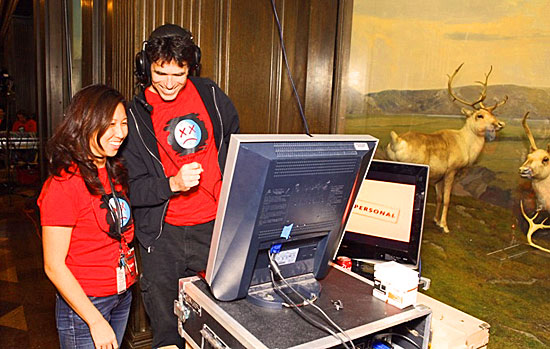
Su Oh at First Friday event, with museum tech expert Michael Wilson, right. Photo/Ryan Miller, Capture Imaging.
Meet Su Oh, the Natural History Museum’s in-house impresario.
Perhaps the only L.A. County employee whose job combines musical cool-hunting, scientific showmanship and a strong sense of theatrical occasion, Oh has been masterminding the museum’s “First Fridays” series for the past five years, presenting programs that combine top-notch lectures with cutting-edge live music.
Thanks in large part to Oh’s efforts, a species once endangered in the museum environment—the young adult—is approaching critical mass.
“At first, people were mainly coming for the concerts,” said Oh, Director of Education and Programs at the museum. “Now, they are coming for the lectures, too. The talks are really starting to rival the music in popularity.”
Oh, 40, formerly worked as an awards manager for the Recording Academy, which produces the Grammys. Five years ago, she decided it was time for a career change, but wasn’t quite sure how to use her entertainment industry experience to her advantage. She hadn’t had science-related experience since college, when she worked at Scripps Institution of Oceanography at the University of California, San Diego.
It just so happened that the Natural History Museum was seeking someone to take over First Fridays and work on boosting attendance. Oh tapped into her music industry experience to identify and book up-and-coming acts. The events began to pick up credibility among young people with an ear for innovative sounds.
Nowadays, the lecturers she schedules are rock stars in their own right, from the astronomer who “killed” Pluto to this week’s Pulitzer-winning presenter, Dr. Jared Diamond, widely known for his scholarship on everything from the birds of Papua New Guinea to the causes of global inequality. Diamond is perhaps best known for his book Guns, Germs, and Steel.
To Oh, great content is always the most important thing. Everything else follows.
“People may not know the bands and they may not know the scientists, but they trust that we are going to find good stuff for them, worth exploring at least,” she said.
Oh, whose duties also include outreach to schools and events like the annual Bug Fair, views First Fridays as “happenings” rather than just concerts or lectures. She has used projections, installation art and even a 14-foot T-Rex puppet to expand the audience’s experience while uniting them with the unique museum environment. Whatever the hook, it appears to be working. First Fridays increasingly draw large crowds, often nearing or reaching capacity.
Those crowds are not likely to dwindle soon. When Phase 1 of Exposition Light Rail Line opens on April 28, it will give the public a new route to the museum’s doorstep.
The stage is set for the Natural History Museum to celebrate its 100th birthday next year. Oh will take a more managerial role on First Fridays after this season, so she can focus more on the big picture. She envisions outdoor events that could host larger crowds while bringing nature lovers and conservationists into the fold.
That inclusivity is a hallmark of Oh’s programs. It’s also what drives her.
“I like connecting people, especially if they are not in each other’s normal realms,” she said. “The bigger gap there is to bridge, the more interested I am in it.”
You can see what the buzz is about at the latest installment of First Fridays this week.
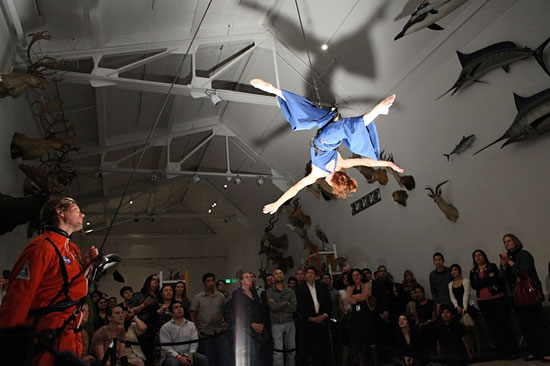
Project Bandaloop performs at the March 2 installment of First Fridays. Photo/Ryan Miller, Capture Imaging.
Posted 3/29/12
Board orders audit of assessor’s office
April 10, 2012
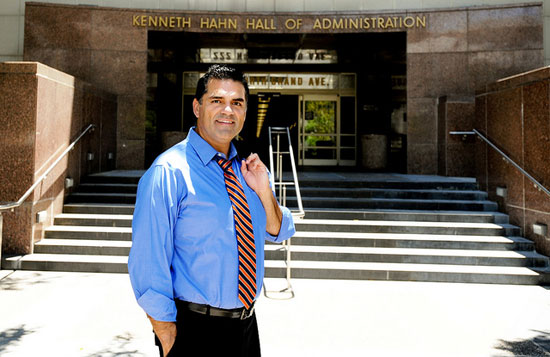
Assessor John R. Noguez blames a surprise drop in property prices for the differences in his forecasts.
Los Angeles County’s assessor came under tough criticism from the Board of Supervisors on Tuesday for producing alarmingly divergent property tax forecasts that could create unexpected headaches for hard-pressed municipalities, school districts and public safety agencies that rely on the funding.
“It’s perplexing, it’s confounding and it’s unprecedented in my time here,” said board Chairman Zev Yaroslavsky, who, with Supervisor Mark Ridley-Thomas, authored a unanimously approved motion ordering an immediate top-to-bottom audit of the assessor’s office.
Assessor John R. Noguez had disclosed to supervisors last week that the county’s 2012-2013 property tax roll would likely generate only a fraction of the net increase he’d forecasted in December, dropping from $18 billion to just $5 billion. On Tuesday, testifying before the board, Noguez blamed the disparity on what he said was a surprising plunge in property values during the final months of last year, with an average 5% tax reduction expected on more than 500,000 parcels.
But Noguez’s explanations, along with those of his chief of staff, seemed only to fuel the supervisors’ concerns about the performance of the assessor’s office, which in recent months has been confronted with allegations that it gave special treatment to certain property owners. Noguez, a 25-year veteran of the assessor’s office who was elected to the top job in 2010, has insisted he’s acted properly and said Tuesday he welcomes a comprehensive review of his office by the county’s auditor-controller.
During the board meeting, Noguez was not asked directly about that controversy. But the tenor of the questioning—and the wording of the audit motion itself—suggested that the supervisors had broader concerns than the revenue forecasts.
“It is imperative that the Board of Supervisors, the governing bodies of other local public agencies and the public have confidence in the Assessor to accurately, efficiently and impartially administer the property assessment process,” Yaroslavsky and Ridley-Thomas wrote in their motion. “The public must be ensured that adequate controls are in place to safeguard the reliability and integrity of the system.”
Although it’s not unusual for variations to exist among property tax forecasts, what made this one so “shocking,” in the words of Supervisor Don Knabe, was that differences between the projected revenue increases were so big—from 1.77% in December to .49% this month. For the county, that represents a potential drop of more than $50 million at a time when the county and other municipalities are hammering out their budgets.
“It’s not simply a matter of numbers but, in fact, real impacts that could adversely affect real human beings,” Ridley-Thomas said.
Chief Executive Officer William T Fujioka, who called the size of the disparities “unprecedented,” said the new audit could show that the assessor’s office got it wrong and that the spread is smaller than currently predicted. “I’m confident [that] through the auditor-controller’s efforts that we’ll get a more accurate picture,” he said.
If the $50 million drop in revenue should hold true, Fujioka said, “I’m confident we’ll be able to address this without any significant reduction in county services.”
That may not be the case elsewhere, as Supervisor Michael D. Antonovich pointedly noted. “This,” he said, “is going to be a severe tsunami to the schools and cities.”
The city of Los Angeles’ chief budget official, Miguel Santana, said in an interview that the difference in forecasts means a potential loss of more than $18 million—“a significant change in terms of how tight our budget is…We’re trying to find solutions to mitigate that gap.” The city is confronting a budget deficit of $222 million.
Santana, like L.A. County officials, said he learned belatedly about that gap only after contacting Noguez for an update. Veterans of the city’s budget office, he said, were stunned by the sharp variances between the earlier and latest forecast. “This is the first time they’ve seen anything so dramatically different.”
Posted 4/10/12
Some bookmark artists who love to read
February 14, 2012
Harry Potter, watch your back.
The imaginative visual artists who just won L.A.County’s 32nd annual bookmark contest are an eclectic bunch when it comes to reading.
While J.K. Rowling’s boy wizard remains a favorite, the bookmark winners report enjoying fiction ranging from French existentialism (The Stranger by Albert Camus) to fantasy from Game of Thrones author George R. R. Martin.
Whoopi Goldberg has a following—both her Big Book of Manners and Sugarplum Ballerina series made the kids’ reading list. Roald Dahl continues to be a popular choice. And magic, in all its forms and at all reading levels, remains incredibly popular, from Magyk to the The Magic Tree House series (and, of course, the Harry Potter books.)
Funny titles—from Dork Diaries to Scumble to My Sister the Vampire—were singled out for mention. So were serious works like The Things They Carried, by Tim O’Brien. One student listed the Bible as her favorite book.
The students, whose bookmark illustrations were chosen from among 11,000 entries, were surveyed about favorite books, hobbies and dreams for the future before their appearance at the Board of Supervisors meeting Tuesday. The contest was open to students from kindergarten to 12th grade; entries were judged in separate categories according to grade level.
The winners from the 3rd District are Francesca “Frankie” Lane Manera (Malibu Public Library), Josias Salvador (San Fernando Public Library, Hunter Blaze Pearson (Agoura Hills Public Library) and Irina Tsoi (West Hollywood Public Library.) For a look at all the winning bookmark creations, click here, or stop by a branch of the Los Angeles County Library this spring.
Posted 2/14/12
L.A.’s ballot box language boom
February 8, 2012

From Bengali to Thai, L.A. County voting officials are brushing up on some new languages for voters.
The nation’s most linguistically diverse ballot is about to offer even more ways to say “I voted.”
This June, when the polls open for the 2012 primary elections,Los Angeles County voters will be able to cast ballots in three new languages and receive oral translations in two more.
The addition of written voting material in Hindi, Khmer and Thai, and the planned recruitment of poll workers who can give bilingual assistance in Gujarati and Bengali, will bring to eleven the number of languages—other than English—in which L.A.County citizens will be able to vote.
Ballots and voting literature have been available for at least a decade in Chinese, Japanese, Korean, Vietnamese, Tagalog, Spanish and English. Registrar-Recorder/County Clerk Dean Logan says the additional voting material and recruitment could cost up to $1 million, but is necessary to comply with the federal Voting Rights Act.
That law generally requires language assistance for voters when a non-English-speaking minority exceeds 10,000 voting age citizens or 5 percent of a jurisdiction’s electorate.
“It’s a federal mandate that unfortunately does not come with federal funding, so we have to absorb it into our own budget,” says Logan. “It’s a challenge, but it’s also a great opportunity to ensure that we’re getting information to people in ways that they can access and comprehend.”
Efrain Escobedo, executive liaison forLogan’s office, attributes the need to a number of factors, including an increase in the number of naturalized citizens from India and Southeast Asia, and the migration of Asian-American voters from other states. Escobedo added that this year’s mandate required extra analysis because it was issued not by nationality, but by ethnicity and race.
“They gave us two categories—Asian Indian and ‘Other Asian Non-Specified,’ ” says Escobedo. “But India has over 122 recognized languages and 22 official languages. So when you tell us ‘Asian Indian,’ that doesn’t really help.”
Meanwhile, a search for non-Indian “other” Asian groups that weren’t already getting bilingual assistance yielded more than 80,000 residents of L.A. County with a half-dozen different national origins.
Eventually, Escobedo says, county analysts narrowed the list with the help of targeted census data, community groups such as the Asian Pacific American Legal Center and the Artesia-based South Asian Network and analysis from the Center for the Study of Immigrant Integration at the University of Southern California.
In addition to leading to the new languages on the ballot and in polling places, the county’s research yielded a rough sketch of the county’s dynamic immigrant populations. For instance:
- Los Angeles County now has more than 1.35 million people who identify themselves as Asian.
- The county’s largest Asian community is non-Taiwanese Chinese, which represents nearly 372,000 people or about 27.5 percent of the Asian community.
- Filipinos run a close second with nearly 329,000 residents, or about 24.3 percent of the county’s Asians. Another 216,000 or so residents are Korean, making up about 16 percent of the Asian community.
- More than 76,000 county residents identified themselves as Asian Indian in the 2010 Census, representing roughly 6 percent of the county’s overall Asian population. More than a third were naturalized citizens.
- About 20,000 of the county’s Asian-Indians are registered voters and more than two out of three have a college degree. The vast majority reported fluency in English, but about one in ten said that they don’t speak it well.
- The county’s immigrant population now includes more than 32,000 Cambodians, 23,000 Thais, 10,000 Indonesians, 9,000 Pakistanis, 6,100 Sri Lankans and 3,000 Laotians.
- Four out of every ten Cambodians are naturalized citizens, and more than a third of the county’s Cambodian population is registered to vote. But nearly 40% of Cambodians over age 25 in the county lack a high school diploma, and a third of the county’s Cambodian population speaks English poorly or not at all.
- The county’s Thai community also reports a 42 percent rate of naturalization. But only about 25 percent reported poor skills in English and more than four in ten have college degrees.
- Los Angeles County’s Thai communities are clustered in Cerritos, Glendale, L.A.and Long Beach. Cambodian clusters can be found in Long Beach, Signal Hill, Lakewood and Pomona. Meanwhile, Asian Indians are concentrated in Artesia, Cerritos, Diamond Bar, Walnut and L.A.
Posted 1/31/12
Looking out for shelter pets
February 8, 2012
The Los Angeles County Board of Supervisors this week weighed in on a narrow-but-emotional debate over euthanasia in animal shelters, urging the governor not to repeal a suspended law requiring shelters to wait more than three days before euthanizing abandoned pets and strays.
The mandate, suspended since 2009, is one of more than 30 that Gov. Jerry Brown has sought to eliminate in the wake of the state’s budget crisis.
Signed into law in 1998 by Gov. Pete Wilson, and named for its sponsor, former Santa Monica state senator Tom Hayden, it has extended the lives of lost and stray animals by requiring shelters to hold them from four to six days, rather than the 72 hours under the prior law. Local governments are supposed to be reimbursed by the state.
As California’s economy has struggled, however, the shelter law has been a target. In 2004, Gov. Arnold Schwarzenegger briefly tried and failed to repeal it, and five years later, it was suspended as part of a deal to balance the state budget. At the time, animal rights groups feared that shelters would begin euthanizing animals more quickly, but they continued to abide by longer waiting periods, making up for the lack of state reimbursement out of their own budgets.
In Los Angeles County, for instance, the Department of Animal Care and Control has spent about $600,000 a year of its $33 million budget to hold animals for five days before euthanization, says Chief Deputy Director David Dijkstra.
“As long as we have the ability, we like to make animals available for adoption or owner redemption for as long as possible,” Dijkstra says, noting that the county impounds about 90,000 animals a year and euthanizes fewer than half of them.
Some animal rights activists have argued that Hayden’s Law has worsened conditions for shelter animals because so-called “rescue holds” by hoarders and well-intentioned but disorganized animal lovers force shelters to house aggressive and diseased animals for weeks at the expense of more adoptable pets who then end up being euthanized for lack of space.
The state also points to a 2008 report from the nonpartisan Legislative Analyst’s Office that found no proof that the Hayden Law had led to an increase in pet adoptions, and therefore recommended repeal.
Still, Brown’s proposal to save more than $23 million a year by taking the mandate out of the state budget has drawn a fresh round of protest from some pet lovers and animal rights groups. Hayden recently spoke out in a YouTube video, and the Humane Society of the United States this week asked members to write to Brown.
The Board’s response, led by Supervisor Michael Antonovich, a longstanding advocate for pet adoptions, took the form of a 5-signature letter asking that the law not be repealed.
Quantifying the local impact of Hayden’s Law has been difficult because so many variables are involved in pet adoptions. For example, in recent years, Dijkstra says, shelters have become more crowded because owners have had difficulty caring for pets in this economy. Moreover, many of the 40,000 or so animals euthanized each year in county shelters are animals such as feral cats that can’t easily be placed for adoption.
However, he notes, by the most available measure—dog impounds—the suspension of Hayden’s Law has not increased euthanasia. In 2008-09, the county impounded 45,903 dogs, with 54 percent adopted or returned to their owners. In 2011-12, the projected number of impounded dogs stands at 48,823, with 57 percent returned or adopted.
About 80 percent of pets are claimed by their owners within the first three days, he says, but last year, about 1,100 lost pets were reunited with their owners on their fourth and fifth days in the shelter. In the past year, he adds, the county also has begun putting abandoned pets up for adoption sooner than they might otherwise have been made available.
“It’s very rare that an owner shows up after we’ve made a dog or cat available for adoption,” he adds, “but that has happened on a couple of occasions, and in those cases, the new owners are contacted and asked if they’ll give the pet back.”
Posted 2/8/12
Crowdsourcing the vote
January 26, 2012
How do you design a secure, reliable, accessible system of voting for a place with 4.3 million voters, 4,500 polling places, 10 languages and more square mileage than two Delawares?
That’s the challenge as Los Angeles County works to update its aging voting system in time for the 2015 elections. Fortunately, a 21st-century innovation—crowdsourcing—just made the job easier.
In a novel approach that is being closely watched by local governments around the nation, the county this week put out the call for public input on how to improve L.A.’s system of voting.
No suggestion is too large or too small, amateurs are as welcome as experts and even off-the-cuff brainstorms are welcome, says Registrar-Recorder/County Clerk Dean Logan.
Anyone with an inspiration, from shorter ballots to voting by cell phones, can respond before March 22 by searching for the accessible elections challenge at www.openideo.com or by clicking here.
“This is just to get peoples’ creative juices going,” Logan says.
The initiative is part of a larger movement to make elections more secure and participatory in the information age. For more than two years, the county has been laying the groundwork for an overhaul of its voting system, the core of which dates to 1968, when the county installed a then-state-of-the-art punch-card system to count ballots.
“Our current system has served us well and with integrity, but the vote-tallying system is based on outdated software,” says Logan. “It’s difficult to get parts and maintenance, some of the equipment isn’t even made anymore, the card readers are becoming obsolete and on the software side, the language doesn’t have the flexibility to be modified.”
Los Angeles County is so vast that none of the commercially available voting systems now on the market can accommodate it, says Logan. Touch-screen voting machines have raised security concerns, he says, and tend to be expensive and logistically unwieldy in a county with 4,500 polling places. Meanwhile, existing paper-based systems being used in other jurisdictions present their own sets of problems when they’re forced to accommodate a system with millions of voters speaking multiple languages and spread across more than 4,000 square miles.
The county had already gone back to the drawing board, surveying poll workers, city clerks, tech experts, stakeholders, vendors, scholars and, of course voters, when Logan was approached several months ago by a federally funded voting project and asked to participate in a so-called “open-innovation challenge” aimed at creating a voting system that would be universally accessible by voters regardless of literacy, language or disability.
The result, he says, was an opportunity to cast a wide net for ideas while continuing the county’s own efforts. The Accessible Voting Technology Initiative, underwritten by a grant from the U.S. Elections Assistance Commission and issued by the county and the Washington, D.C.-based Information Technology and Innovation Foundation, will take input from anyone with an idea.
Logan says the county faces a number of challenges in developing its own system; for one thing, federal and state regulators will have to approve any system that is developed. Also state legislation will have to be tweaked for the county to spend money on anything but a system now on the commercial market.
“We hope this challenge will accelerate the idea process,” says Logan. “By the end of summer—and granted, by then we’ll be doing the 2012 elections—we hope by then we might even have some prototypes.”
Posted 1/26/11
Spot a pothole? Give it “The Works”
December 7, 2011
If you’ve ever wished you could zap a pothole or wipe out some graffiti, the county Department of Public Works has a message for you: the power’s in your hands.
Or, to be precise, on your iPhone.
The department’s new “The Works” app offers a point-and-shoot approach to cleaning up quality of life nuisances in county territory, including illegal dumping and street sweeping issues.
Once the free app is downloaded, you can use the camera on your iPhone to send Public Works an instant image of the problem, get a ticket number and keep tabs on how the issue is resolved. (It’s also possible to send a message about the problem without including a photo.) If the location is not within the county’s jurisdiction, the app detects that and directs the customer to the appropriate agency. Jesse Juarros, the department’s chief information officer, said the “end game” is eventually to get all cities within L.A.County to join up so that reports can be forwarded seamlessly to the right place.
Since it was launched Oct. 18, the app has been downloaded 700 times—with more than 330 service requests received, including referrals to other cities.
“Most of them are for potholes, as you’d expect,” Juarros said. “The other one that ranked up there was illegal dumping.”
The new app is “definitely” contributing to quicker graffiti removal, Juarros said, because notifications go directly to clean-up contractors, who can take action right away.
Droid or Blackberry users can take advantage of the same services through the department’s mobile site. And they’re available to all via the regular DPW website.
Posted 11/9/11
Sergeant to the stars calls it quits
November 30, 2011

Sgt. Steve Wheatcroft, escorting Lindsay Lohan into court last year, is no mystery man to those in the know. Photo/AP
The photo captions dub him the “unidentified man,” whether he’s escorting Lindsay Lohan through a blizzard of golden confetti or guiding Mel Gibson through a gauntlet of paparazzi.
But everybody who’s anybody in Los Angeles County courthouse and government circles knows that the tall, broad-shouldered figure in those pictures is Steve Wheatcroft.
The veteran county sheriff’s sergeant has long been an unsung but essential player on the front lines of L.A.’s celebrity-media circus, bringing decorum and safety to the courtroom comings and goings of America’s most photographed.
He’s been responsible for the security of judges like Lance Ito, who presided over O.J. Simpson’s murder trial. He’s made sure that defendants like Lohan, Gibson, Phil Spector and Dr. Conrad Murray made it through media scrums and into courtrooms with a minimum of chaos. And whenever a threat is made against a Los Angeles County judge or member of the Board of
Supervisors, Wheatcroft and his team have jumped into action.
But now, after more than two decades of rubbing shoulders with L.A.’s famous and infamous, Wheatcroft is ready for a little family time.
“As they always say at the Super Bowl, I’m going to Disneyland,” said Wheatcroft, 54, who will retire in the next few weeks after more than 32 years on the job.
Instead of heading up the sheriff’s Security Operations Unit—which assesses threats on public officials, helps manage high-profile trial logistics and provides protection to supervisors and judges—he’ll be hanging with his eight (soon to be nine) grandchildren and cruising around in his black ’59 Corvette.
Leaving the job is kind of like leaving the family business for Wheatcroft, whose brother and son also work for the sheriff’s department.
More than anything, he said, he’ll miss the camaraderie of the eight-member unit that he joined back when it was just a two-man operation run out of the county marshal’s office. When the marshal’s office merged with the Sheriff’s Department in 1994, Wheatcroft’s unit took over protective services for the supervisors as well as the judges. As part of the job, he has served as sergeant-at-arms for the Board of Supervisors’ meetings and helped with logistics for visiting dignitaries ranging from Muhammad Ali to Kirk Douglas.
At Tuesday’s board meeting, the supervisors gave Wheatcroft a big send-off.
“All I can say is this is the sweetest cop you will ever meet,” said Supervisor Gloria Molina. “But that doesn’t take away the kind of commanding presence that he has had here at the board.”
Supervisor Zev Yaroslavsky saluted his professionalism and ability to “defuse situations that could have gone the other way,” including threats made against the supervisor or his staff. “You put me and my family at ease during those moments,” Yaroslavsky told Wheatcroft.
Supervisor Michael D. Antonovich thanked Wheatcroft and also singled out his work in the courts. Ticking off a long list of celebrity defendants the sergeant has escorted, he noted: “You could see him in all the movie magazines.”
Which is true, actually, but doesn’t seem to have gone to his head.
Over the years, the “unidentified man” in all those photos has had the chance to observe a lot of famous people under difficult circumstances.
Lohan, Wheatcroft said, is “just kind of a confused girl” who told him she “likes to party.”
Nicest celeb? That would be Rod Stewart, whom Wheatcroft accompanied during a week-long civil proceeding at the courthouse. The British rocker was, in Wheatcroft’s words, “a humble, appreciative person.”
Close followers of the O.J. Simpson case may remember the time the jury, lawyers and judge in the so-called “trial of the century” took a field trip to Simpson’s Rockingham Avenue estate. Wheatcroft arranged it. He did the same with an excursion to Vitello’s restaurant during the Robert Blake case.
And—as if Los Angeles County didn’t have enough of its own well-known defendants—Wheatcroft has been called in to advise officials elsewhere in the U.S.and Canada on how to handle high-profile proceedings. He’s written on the subject in Officer magazine.
By his side throughout has been his high-school sweetheart and now-wife, Wanda. After the board send-off Tuesday, she said her husband had often shared tales from his star-studded work over the years.
“But only in an entertaining way,” she said, “never in a complaining way.”
Posted 11/30/11
Coroner cleans up at awards time
November 3, 2011
Los Angeles County appreciates efficiency, and the coroner has the evidence to prove it.
After DNA revolutionized forensic science, criminal cases that had been “cold” for years suddenly got warmer. Law enforcement agencies formed special units to take fresh looks at them, and coroner’s Evidence Control Unit, which keeps material from more than 60,000 homicides, found itself flooded with requests.
Before 2008, that evidence was stored warehouse-style, each piece catalogued numerically. Evidence from one homicide could be spread across several rooms within piles of other evidence, which made gathering it a time-consuming chore. Before the widespread use of DNA testing, the evidence unit received very few requests from police, so easy access wasn’t a priority. In most cases, law enforcement agencies didn’t even know the evidence was there.
Enter Michelle Sandberg. In 2008, Sandberg, who was working as a toxicologist, was chosen to bring the unit into the new era, to meet the new demand. Due to budget constraints she could not hire extra hands, so she enlisted volunteers from universities and the military to help her and two other staffers come up with a new way of doing business.
Their efforts paid off. On October 19, the evidence control unit makeover will be honored as one of the ten most innovative programs in the county at the 25th Annual Productivity and Quality Awards luncheon. The top three programs among them will win Bronze, Silver and Gold Eagle awards. Winners can then submit applications for awards from the California State Association of Counties and the National Association of Counties.
This year’s other honorees range from a groundwater reclamation program that saves an estimated $236 million annually to a free-for-taxpayers high school STD prevention program that has health and educational benefits that aren’t easily monetized.
The awards are presented by the county’s Quality and Productivity Commission. Over the past 25 years, the programs it has recognized have saved taxpayers an estimated $3.6 billion. Winners are also highlighted in an annual multimedia report, which promotes “best practices” countywide. (See last year’s report here.)
Ruth Wong, executive director of the commission, said the goal is to inspire copycats. “What we are hoping is that all or part of these projects will be picked up by other departments. We want them to spread.”
Already, news of the evidence unit’s success is spreading. The National Institute of Justice sent a representative to have a look at Sandberg’s shop two weeks ago. Sandberg, now acting supervising criminalist, and the director of the coroner’s office, Anthony T. Hernandez, have been invited to Washington, D.C. this March to address the Working Group for Medicolegal Death Investigation, which establishes nationwide standards for evidence management.
She will explain how her team tackled the problem, organizing the evidence in “kits” for each case. Each was labeled with a case number and a list of contents, and added to a computer database shared by 145 agencies nationwide. The Los Angeles Police Department and the L.A. County Sheriff now work closely with the unit, lending staff and advice.
Sandberg’s system has become so efficient that she has started contacting law enforcement agencies herself so they can “come get their stuff.” Out of the 280,000 pieces of evidence her unit housed, only 30,000 remain. As a result of that effort, 41,000 cases have been processed in two years, and decades-old murders and rapes have been solved.
Recognition for her unit’s transformation is great, Sandberg said, but even more gratifying is the sense of contributing to those successful investigations. “It is rewarding because of the work the detectives have done on the cases, using the evidence,” she said. “There is justice for the victims’ families and for all the people who have worked so hard to get it.”
Posted 10/6/11








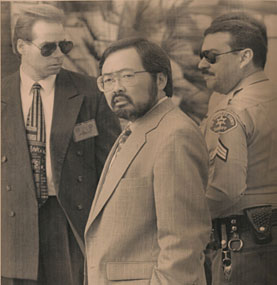

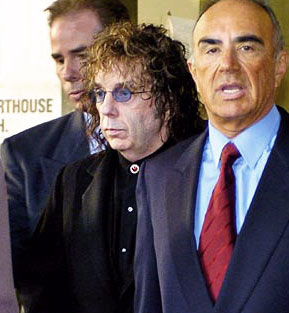
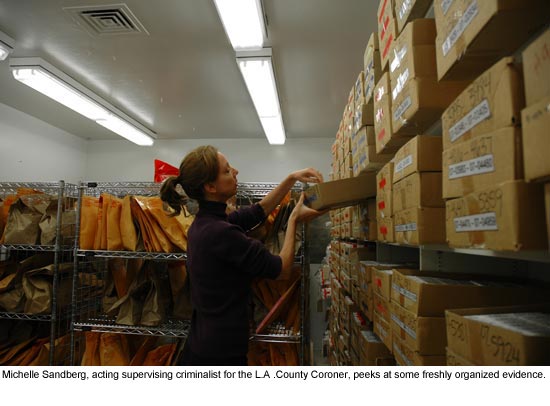







 405 bridge work causes a stink
405 bridge work causes a stink
